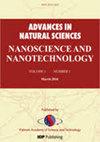用于吸附水中重金属离子的聚乙烯吡咯烷酮/热还原石墨烯混合物
IF 2.1
Q3 MATERIALS SCIENCE, MULTIDISCIPLINARY
Advances in Natural Sciences: Nanoscience and Nanotechnology
Pub Date : 2023-11-16
DOI:10.1088/2043-6262/ad08a1
引用次数: 0
摘要
本文介绍了改性聚乙烯吡咯烷酮(PVP)/石墨烯混合物的制备方法,并评估了其对水中重金属离子的吸附能力。石墨烯是通过悍马法从石墨中合成的氧化石墨(GO)热分离得到的,具有约 362 m2 g-1 的高比表面积。石墨烯-PVP 混合物的制备方法是将石墨烯分散到 PVP 溶液中,然后进行交联以防止水的冲刷。这种交联确保了石墨烯-PVP 混合物的良好分散性和稳定性。在 pH 值为 3 和接触时间为 30 分钟的条件下,石墨烯-PVP 对 Cu2+ 和 Cd2+ 离子的最大吸附容量分别为 158 mg g-1 和 134 mg g-1。实验结果与 Langmuir 和伪二阶动力学模型一致。研究进一步揭示了 Cu2+ 和 Cd2+ 离子在石墨烯-PVP 上的吸附机制遵循离子交换机制,由 PVP 和金属离子之间的强相互作用驱动。该研究为制备高吸附性石墨烯-PVP 材料提供了一种简便、低成本和环保的方法。本文章由计算机程序翻译,如有差异,请以英文原文为准。
Blend of polyvinylpyrrolidone/thermally reduced graphene for adsorption of heavy metal ions in water
This paper presents the preparation of a modified polyvinylpyrrolidone (PVP)/graphene mixture and evaluates its adsorption capacity for heavy metal ions in water. Graphene with a high specific surface area of about 362 m2 g−1 was obtained through the thermal separation of graphite oxide (GO), which had been synthesised from graphite by the Hummer method. The graphene-PVP blend was prepared by dispersing the graphene into a PVP solution and then crosslinking it to prevent washout by water. This crosslinking ensured a well-dispersed and stable graphene-PVP blend. The maximum adsorption capacity of graphene-PVP for Cu2+ and Cd2+ ions was found to be 158 mg g−1 and 134 mg g−1, respectively, at pH 3 and a contact time of 30 min. The experimental results were found to be consistent with Langmuir and pseudo-second-order kinetic models. The study further reveals that the adsorption mechanism of Cu2+ and Cd2+ ions on graphene-PVP follows an ion exchange mechanism, driven by strong interactions between PVP and metal ions. The study provides an easy, low-cost, and eco-friendly method to produce highly adsorptive graphene-PVP materials.
求助全文
通过发布文献求助,成功后即可免费获取论文全文。
去求助
来源期刊

Advances in Natural Sciences: Nanoscience and Nanotechnology
NANOSCIENCE & NANOTECHNOLOGYMATERIALS SCIE-MATERIALS SCIENCE, MULTIDISCIPLINARY
自引率
4.80%
发文量
0
 求助内容:
求助内容: 应助结果提醒方式:
应助结果提醒方式:


